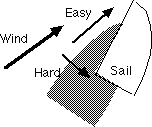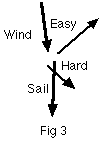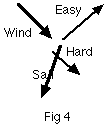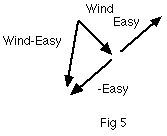There are a few steps between here and the final mystery, so
lets start with a simpler situation.
 The shape of the boat makes it very easy to go in
the forward or backwards direction, but very difficult to go
sideways. (See Fig. 1) No surprise here. Thus as long as the
wind is more or less in the Easy direction, and the sail is
perpendicular to it, the wind will "push" us along. The very
first sailboats used what is called "square rigging" which
means the sail was a square sheet that was always "pushed"
along by the wind. As long as the wind was blowing in the
direction that you wanted to travel in, you were home free,
but if you wind changed directions, you had few options other
than to let down your sail and wait. Nevertheless, this is how
many ships sailed, until well into the 18th century. In fact
it was Christopher Columbus's great innovation that he would
be able to sail over to Cipango (in medieval mythology, an
island off the eastern coast of Asia, perhaps modern-day
Japan) using the northeast trade winds and back by using the
variable westerly winds which are encountered further south in
the winter when they blow in the horse latitudes (30 degrees
north of the equator. Where in the summer there is so little
wind that boats often become becalmed.) Just as an aside, this
is the origin of the phrase
to be in the doldrums, as at this latitude there is little
wind, and hence it is difficult to get going.
The shape of the boat makes it very easy to go in
the forward or backwards direction, but very difficult to go
sideways. (See Fig. 1) No surprise here. Thus as long as the
wind is more or less in the Easy direction, and the sail is
perpendicular to it, the wind will "push" us along. The very
first sailboats used what is called "square rigging" which
means the sail was a square sheet that was always "pushed"
along by the wind. As long as the wind was blowing in the
direction that you wanted to travel in, you were home free,
but if you wind changed directions, you had few options other
than to let down your sail and wait. Nevertheless, this is how
many ships sailed, until well into the 18th century. In fact
it was Christopher Columbus's great innovation that he would
be able to sail over to Cipango (in medieval mythology, an
island off the eastern coast of Asia, perhaps modern-day
Japan) using the northeast trade winds and back by using the
variable westerly winds which are encountered further south in
the winter when they blow in the horse latitudes (30 degrees
north of the equator. Where in the summer there is so little
wind that boats often become becalmed.) Just as an aside, this
is the origin of the phrase
to be in the doldrums, as at this latitude there is little
wind, and hence it is difficult to get going.
A physicist's view of the above drawing would look like Fig 2.
 The wind is blowing along the length of the boat,
and the sail is being held at right angles to the wind. All of
the force provided by the wind is directed along the length of
the boat, in the "easy" direction.
The wind is blowing along the length of the boat,
and the sail is being held at right angles to the wind. All of
the force provided by the wind is directed along the length of
the boat, in the "easy" direction.
The next level of complexity happens when we sail "into" the
wind. The physicists view of this looks like Fig 3. The wind is
coming from the front of the boat, and the sail has moved towards
the back of the boat. From the picture it looks like the boat
should be moving backwards, but it doesn't, so something else must
be going on here. Part of the mystery is the shape of the sail,
which must be triangular, and when it is positioned relative to the
wind as in Fig 3 it takes the shape of an airfoil, or the wing of
an airplane.
 Now if you read about this in most books they
will tell you that because of the Bernoulli effect the
pressure on the curved part of a wing is lower than the
pressure on the straight part of a wing because the air has to
move faster over the curved part than over the straight part.
Uh, excuse me, but while that may be true, is it supposed to
be obvious? It sure isn't obvious to me that it has to work
that way. Well, here at the Pacific Pearl we go that extra
mile to uncover the real workings of nature. We can easily
demonstrate the Bernoulli effect with any ordinary piece of
8.5 by 11 inch paper. Just hold the two corners of the 8.5
inch side between your two hands, letting the rest of the
paper hang down. Raise the edge to your lips and blow across
the paper. The paper rises up as you blow across it,
illustrating the Bernoulli effect. So the crucial question is,
why is the pressure lower when the air speed is higher? The
answer comes from the basic principle known as the
conservation of energy. This is one of the basic principles of
physics, that says you can't make energy appear or disappear,
you can only make it change form. Physicists love this kind of
principle, because it means if you can calculate how much
energy there is in a given situation, then you know it will
never change.
Now if you read about this in most books they
will tell you that because of the Bernoulli effect the
pressure on the curved part of a wing is lower than the
pressure on the straight part of a wing because the air has to
move faster over the curved part than over the straight part.
Uh, excuse me, but while that may be true, is it supposed to
be obvious? It sure isn't obvious to me that it has to work
that way. Well, here at the Pacific Pearl we go that extra
mile to uncover the real workings of nature. We can easily
demonstrate the Bernoulli effect with any ordinary piece of
8.5 by 11 inch paper. Just hold the two corners of the 8.5
inch side between your two hands, letting the rest of the
paper hang down. Raise the edge to your lips and blow across
the paper. The paper rises up as you blow across it,
illustrating the Bernoulli effect. So the crucial question is,
why is the pressure lower when the air speed is higher? The
answer comes from the basic principle known as the
conservation of energy. This is one of the basic principles of
physics, that says you can't make energy appear or disappear,
you can only make it change form. Physicists love this kind of
principle, because it means if you can calculate how much
energy there is in a given situation, then you know it will
never change.
But what is energy? We all know it is expensive, every time we get our electric bill, but what is it really? The simple answer is that energy is the ability to do something useful, in physicist's language, it is the ability to do "work." "Work" means pushing or pulling something for a certain distance. For example, if you climb to the top of a building, you are doing "work" against the pull of gravity. The amount of work you are doing depends on how many pizzas you ate, ie your weight, and how tall the building is, ie the distance up. From an energy viewpoint, you are converting the stored chemical energy in your body, (those pizzas again) to a "potential energy" which is your height above the ground. If you were to jump from the building, you would convert that "potential energy" into kinetic energy, or the energy of motion, at least until you hit the ground with a big splat. After everything stopped moving, this kinetic energy would have been converted into heat energy, the heat you caused by rubbing your body against the ground below. Throughout this whole process, no energy was created or destroyed, it only changed form, from chemical energy at the beginning of the climb to heat energy at the end. What does this have to do with the Bernoulli effect? Well, let us ask ourselves the question, what kind of energy does air have? It has heat energy, as everyone knows when the sun comes out. However, the air temperature doesn't really change as it flows across a wing, so we can ignore the heat energy since it is the same before and after it crosses the wing. Air has pressure, in fact we are told in high school that the air pressure at sea level is 14 pounds per square inch. Pressure must be related to energy, since if we have a tank of air at high pressure, we can blow things around with it as we release the air. In fact the pressure in a volume of air is like the potential energy we met earlier. The higher the pressure, and the larger the volume the more "pressure energy" we have stored. Finally, air can have kinetic energy, as any windmill owner will tell you. Now it should be getting obvious. A bunch of air moves across a wing. Since you can't spontaneously create air, the amount of air that enters the front of the wing must also leave the rear of the wing. Clearly in order for this to happen, it must move faster over the top curved surface than over the bottom flat surface, after all, it has further to go. Energy is conserved, so the pressure energy plus the kinetic energy stays constant. Now on the top of the wing, the air is moving faster, so it has more kinetic energy, therefore it must have less pressure energy, and so the plane flies. That is also exactly how a sailboat is able to sail against the wind. The shape of the sail causes the air to flow over the front of the sail faster than the back, reducing the pressure, and in essence "sucking" the boat forward. One mystery solved.
The next mystery occurs when the wind is more or less at right
angles to the boat as in Fig 4.
 As every wind surfer knows, this is where you
really want to be. We have to imagine that the boat is already
moving in the "Easy" direction. Now, as anyone who has driven
a convertible knows, even if there is no wind outside, if you
are driving along at 20mph and you stand up and put your face
over the top of the windshield, you will find a 20mph wind
blowing in your face. You will also discover what insects
taste like. Similarly, if there is a 20mph wind blowing, say,
from your left while you are driving 20mph straight ahead,
your face would experience a wind of about 28mph wind coming
diagonally from your left-front. Well, the same thing happens
if you are sailing on a boat. The two winds, the "real" wind
that would be blowing even if you were standing still, and the
"headwind" that is there because you are moving, combine to
form an "apparent" wind that will be more towards the front of
the boat, and harder than either wind alone. The exact speed
and direction of this apparent wind is found by "vector
addition" as show in Fig 5.
As every wind surfer knows, this is where you
really want to be. We have to imagine that the boat is already
moving in the "Easy" direction. Now, as anyone who has driven
a convertible knows, even if there is no wind outside, if you
are driving along at 20mph and you stand up and put your face
over the top of the windshield, you will find a 20mph wind
blowing in your face. You will also discover what insects
taste like. Similarly, if there is a 20mph wind blowing, say,
from your left while you are driving 20mph straight ahead,
your face would experience a wind of about 28mph wind coming
diagonally from your left-front. Well, the same thing happens
if you are sailing on a boat. The two winds, the "real" wind
that would be blowing even if you were standing still, and the
"headwind" that is there because you are moving, combine to
form an "apparent" wind that will be more towards the front of
the boat, and harder than either wind alone. The exact speed
and direction of this apparent wind is found by "vector
addition" as show in Fig 5.
 Perhaps you remember we encountered it before in
my article on Tides. Notice that this apparent wind, which is
the wind felt by the sail, is always larger than the "real"
wind that is blowing. Also notice that the faster you go, the
more directly you are sailing "into" this apparent wind. By
carefully controlling the angle your sail makes with this
apparent wind, you can wind up going considerably faster than
the "real" wind is blowing. (Isn't English wonderful, how did
you pronouncing the second "wind" in the previous sentence?)
Another
Perhaps you remember we encountered it before in
my article on Tides. Notice that this apparent wind, which is
the wind felt by the sail, is always larger than the "real"
wind that is blowing. Also notice that the faster you go, the
more directly you are sailing "into" this apparent wind. By
carefully controlling the angle your sail makes with this
apparent wind, you can wind up going considerably faster than
the "real" wind is blowing. (Isn't English wonderful, how did
you pronouncing the second "wind" in the previous sentence?)
Another
If there is a topic you would like to see discussed here, send an email to Henry at nadine.and.henry@pobox.com Adios.
Thanks to Hugh Rance for pointing out an error in this article and sending me a correction.

Pomeranians speak only to Poodles and Poodles speak only to God.
Charles Kuralt on 48 Hours
Sitemap
Go up to How do Things Work Go up to Home Page of Nadine Loves Henry
Go back to A Horse is a Force, of Course of Course Continue with Why is the Sky Blue, Daddy